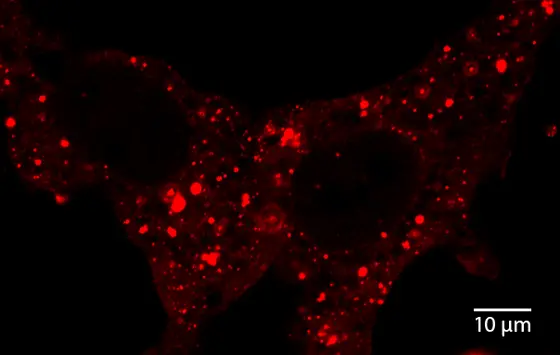Hydrogen peroxide (H2O2) is a strong oxidizer and is used as a bleaching agent for hair and teeth, and as a wound disinfectant. In addition, H2O2 also forms in the body, for example as a metabolic product of cellular respiration. It belongs to a group of chemicals called reactive oxygen species (ROS), which scientists suspect to have a damaging effect on cells and their components. For example, they are believed to play a role in carcinogenesis, degenerative diseases, and even aging. Body cells contain large quantities of enzymes called peroxiredoxins that degrade H2O2 and have been believed to act as a protection against the supposedly dangerous H2O2molecules.
About ten years ago, research results showed that things are not quite as simple as that: “Under most conditions, H2O2 is not an undesired side product but rather an essential chemical messenger that plays an important role in regulating the way in which body cells respond to signals from outside such as hormones and growth factors," says Dr. Tobias Dick of the German Cancer Research Center (Deutsches Krebsforschungszentrum, DKFZ). “We know today that the body’s own H2O2 is vital for signal processing in a healthy organism." H2O2 transmits signals by oxidizing specific proteins at particular sites, thereby alternatively turning them on or off. Dick and his co-workers have now been the first to show the molecular mechanisms behind this signaling through specific oxidation in human cells.
This mechanism has long been enigmatic for scientists: A signaling molecule needs to act specifically. How can a tiny molecule like H2O2, which is hardly any larger than a water molecule (H2O), specifically oxidize particular proteins while leaving others completely unaffected? And why is it that the relatively small amounts of H2O2 that are produced for signaling are not immediately captured by peroxiredoxins before H2O2 can even react with target proteins?
Dick’s team has now shown that the solution is as simple as it is elegant. The DKFZ researchers proved that H2O2 is in fact captured by peroxiredoxins immediately after forming. What happens next, however, came as a surprise: The peroxiredoxins used H2O2 to oxidize other proteins. This means that they do in fact catch H2O2, though not in order to prevent its oxidative effect but rather to orderly direct them to very specific targets. Unlike the tiny H2O2 molecule, peroxiredoxins can interact specifically with other proteins. Thus, they are able to target and oxidize other proteins in order to regulate their function. The oxidative alteration of the target proteins is only temporary and does not cause any damage.
The researchers used an example to demonstrate the mechanism: They identified the transcription factor STAT3, which regulates inflammatory processes and can promote tumor
development, as a prominent target protein of one peroxiredoxin. They were able to show that the peroxiredoxin transmits the oxidative effect of H2O2 to STAT3. The oxidation status of STAT3, in turn, determined how efficiently the transcription factor regulates gene activity. Contrary to all previous assumptions, the researchers were able to exclude the possibility of direct and spontaneous oxidation of STAT3 by free H2O2.
“Tumor cells produce larger quantities of H2O2 and use oxidative signals at higher levels than normal cells in order to drive their own growth," says Mirko Sobotta, first author of the publication. “Now that we have identified the peroxiredoxins as key players in specific oxidation, we can target them in order to interfere with cancer-relevant oxidative signals."
The new study does not only unravel a fundamental problem of biology but it also uncovers a new level of regulation for the cancer-relevant transcription factor STAT3. The research project is part of the Collaborative Research Center 1036 (SFB 1036), which pursues research on basic mechanisms of cellular regulation within the DKFZ-ZMBH alliance.
Sobotta, M.C., Liou, W., Stöcker, S., Talwar, D., Oehler, M., Ruppert, T., Scharf, A.N., and Dick, T.P. (2014). Peroxiredoxin-2 and STAT3 form a redox relay for H2O2 signaling. Nature Chemical Biology 2014, DOI: 10.1038/nchembio.1695.
About DKFZ
With more than 3,000 employees, the German Cancer Research Center (Deutsches Krebsforschungszentrum, DKFZ) is Germany’s largest biomedical research institute. DKFZ scientists identify cancer risk factors, investigate how cancer progresses and develop new cancer prevention strategies. They are also developing new methods to diagnose tumors more precisely and treat cancer patients more successfully. The DKFZ's Cancer Information Service (KID) provides patients, interested citizens and experts with individual answers to questions relating to cancer.
To transfer promising approaches from cancer research to the clinic and thus improve the prognosis of cancer patients, the DKFZ cooperates with excellent research institutions and university hospitals throughout Germany:
- National Center for Tumor Diseases (NCT, 6 sites)
- German Cancer Consortium (DKTK, 8 sites)
- Hopp Children's Cancer Center (KiTZ) Heidelberg
- Helmholtz Institute for Translational Oncology (HI-TRON Mainz) - A Helmholtz Institute of the DKFZ
- DKFZ-Hector Cancer Institute at the University Medical Center Mannheim
- National Cancer Prevention Center (jointly with German Cancer Aid)
The DKFZ is 90 percent financed by the Federal Ministry of Research, Technology and Space and 10 percent by the state of Baden-Württemberg. The DKFZ is a member of the Helmholtz Association of German Research Centers.



